
Solidago, commonly called goldenrods, is a genus of about 100 to 120 species of flowering plants in the family Asteraceae. Most are herbaceous perennial species found in open areas such as meadows, prairies, and savannas. They are mostly native to North America, including Mexico; a few species are native to South America and Eurasia. Some American species have also been introduced into Europe and other parts of the world.

Goldenrod is a common name for many species of flowering plants in the sunflower family, Asteraceae, commonly in reference to the genus Solidago.
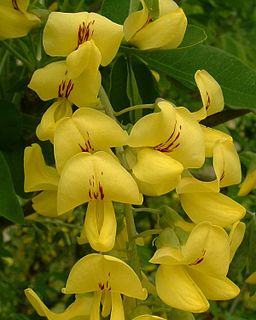
Laburnum, sometimes called golden chain or golden rain, is a genus of two species of small trees in the subfamily Faboideae of the pea family Fabaceae. The species are Laburnum anagyroides—common laburnum and Laburnum alpinum—alpine laburnum. They are native to the mountains of southern Europe from France to the Balkans.

Polemonium, commonly called Jacob's ladders or Jacob's-ladders, is a genus of between 25 and 40 species of flowering plants in the family Polemoniaceae, native to cool temperate to arctic regions of the Northern Hemisphere. One species also occurs in the southern Andes in South America. Many of the species grow at high altitudes, in mountainous areas. Most of the uncertainty in the number of species relates to those in Eurasia, many of which have been synonymized with Polemonium caeruleum.

Potentilla indica known commonly as mock strawberry, Indian-strawberry, or false strawberry, often referred to as a backyard strawberry, mainly in North America, is a flowering plant in the family Rosaceae. It has foliage and an aggregate accessory fruit similar to that of a true strawberry. It has yellow flowers, unlike the white or slightly pink flowers of true strawberries. It is native to eastern and southern Asia, but has been introduced to many other areas as a medicinal and an ornamental plant, subsequently naturalizing in many regions worldwide.

Solidago canadensis, known as Canada goldenrod or Canadian goldenrod, is an herbaceous perennial plant of the family Asteraceae. It is native to northeastern and north-central North America and often forms colonies of upright growing plants, with many small yellow flowers in a branching inflorescence held above the foliage. It is an invasive plant in other parts of the continent and several areas worldwide, including Europe and Asia. It is grown as an ornamental in flower gardens.

Symphyotrichum lateriflorum is a species of flowering plant in the aster family (Asteraceae). Commonly known as calico aster, starved aster, and white woodland aster, it is native to eastern and central North America. It is a perennial and herbaceous plant that may reach heights up to 120 centimeters and widths up to 30 cm (1 ft).
Crataegus coccinioides is a species of hawthorn known by the common names Kansas hawthorn and large-flowered cockspurthorn. Crataegus coccinioides is native from Kansas, to New England, and the southernmost parts of Ontario and Quebec. It has large flowers and leaves and fruit that appear pinkish until polished to reveal the red colour underneath the wax bloom. Crataegus coccinioides is a synonym of Crataegus dilatata.

Solidago nemoralis is a species of flowering plant in the family Asteraceae. It is native to North America, where it is widely found in Canada and the United States. Its common names include gray goldenrod, gray-stem goldenrod, old-field goldenrod, field goldenrod, prairie goldenrod, dwarf goldenrod, and dyersweed goldenrod.
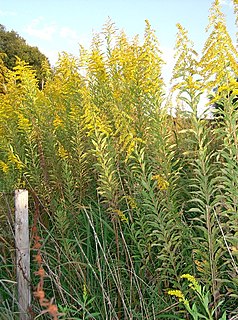
Solidago altissima, the tall goldenrod or late goldenrod, is a North American species of goldenrod widespread across much of Canada, the United States, and northern Mexico. It is common in much of its range, and fairly tolerant of landscapes which have been disturbed by humans. It has become naturalized in many parts of the world.

Solidago gigantea is a North American plant species in the family Asteraceae. Its common names include tall goldenrod and giant goldenrod, among others.
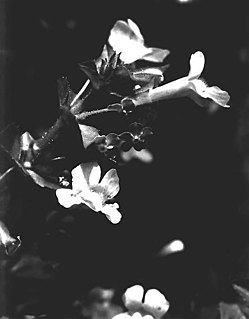
Erythranthe michiganensis is a rare species of flowering plant in the lopseed family, known by the common name Michigan monkeyflower. This species occurs only in the Grand Traverse and Mackinac Straits areas within the American state of Michigan. It is one of only three plant species that are endemic to Michigan, with the other two being Voss's Goldenrod and Packera insulae-regalis.

Solidago houghtonii is a rare North American species of flowering plant in the family Asteraceae known as Houghton's goldenrod. It is native to southern Ontario, Canada and the northern United States. It is threatened by the loss and degradation of its habitat. It is a federally listed threatened species of the United States and it is designated a species of special concern by Canada's Committee on the Status of Endangered Wildlife in Canada.

Solidago ptarmicoides, the prairie goldenrod, white flat-top goldenrod or upland white aster, is a North American perennial flowering plant in the family Asteraceae. It is native to the central and eastern Canada and parts of the United States (mostly Great Lakes region, the Northeast, the Ozarks, and the northern Great Plains, with isolated populations in Wyoming, Colorado, Oklahoma, and scattered locations in the Southeast. It has also been called upland white solidago, upland white goldenrod, and sneezewort goldenrod
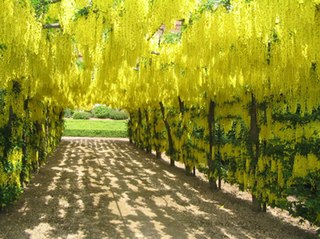
Laburnum × watereri, is a naturally occurring hybrid species of Laburnum, native to Central Europe. Its parents are common laburnum, Laburnum anagyroides, and alpine laburnum, Laburnum alpinum. A small deciduous tree or large shrub, it is a popular garden plant, called golden chain tree for its spectacular display of hanging clusters of yellow pea-like blossoms. It can be trained to take forms such as arches and espaliers.

Symphyotrichum ciliolatum, commonly known as Lindley's aster and fringed blue aster, is a perennial herb native to Canada and the northern United States. It is also known as ciliolate wood aster and northern heart-leaved aster. The common name Lindley's aster honours John Lindley who first described the species in 1834.
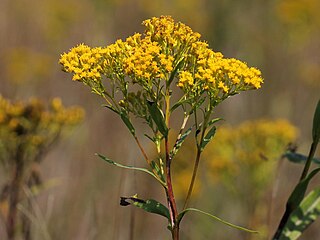
Solidago sect. Ptarmicoidei is a section of flowering plants in the genus Solidago. They are sometimes considered a separate genus: Oligoneuron. Like related species they are known as goldenrods. This section contains seven species of perennial herbs, all native to North America. They are distinguished from other goldenrods by their corymbiform flowerheads, which are flat or rounded in profile and about as broad as tall or broader, for which they are sometimes called flat-topped goldenrods.

Symphyotrichum urophyllum is a species of flowering plant in the family Asteraceae native to eastern North America, commonly known as arrowleaf aster.

Symphyotrichum robynsianum is a species of flowering plant in the family Asteraceae native to northeastern North America. Common names include Robyn's aster and long-leaved aster.

Epilobium coloratum, known by the common names purpleleaf willowherb and cinnamon willow-herb, is a species of flowering plant in the genus Epilobium of the willowherb family Onagraceae. This species is native to the Midwest and Eastern United States, as well as the Canadian provinces of Ontario, Québec, New Brunswick, Nova Scotia, and Newfoundland. It is also native to the Dominican Republic and Haiti.




















